As promised last week, we’ll be having a look at the numbers being put up so far in the starting weeks of the Extended PTQ season, with a key eye specifically for comparing it to the reported MTGO metagame and attempting to establish a relative timeline as to how these two things interact. To the best of my knowledge, the difference between paper Magic and electronic Magic has never been charted specifically before, with an attempt to see how the two interact and how quickly ideas and trends from one port over to the second. We start first with the data presented on 01/25/07 by Mike Flores in Swimming With Sharks, and will be referencing heavily all of Frank Karsten’s Online Tech articles between the World Championships at the start of December and his first article back from the Winter break, documenting Weeks 48 – 52 of the 2006 online Extended metagame.
| Deck | # in PTQ Top Eights | % Share of Top 8 Appearances |
|
Boros Deck Wins
|
0
|
0%
|
|
Scepter-Chant
|
4
|
6.67%
|
|
Aggro-Loam / The CAL
|
4
|
6.67%
|
|
UW Tron / UW Cloudpost
|
14
|
23.33%
|
|
Flores G/W
|
2
|
3.33%
|
|
Flow Deck Wins / Aggro Flow Rock
|
3
|
5%
|
|
Affinity
|
3
|
5%
|
|
Domain Aggro
|
3
|
5%
|
|
Non-Aggro Rock / Gifts Rock
|
5
|
8.33%
|
|
Friggorid
|
2
|
3.33%
|
|
Trinket Angel
|
2
|
3.33%
|
|
U/G Opposition
|
2
|
3.33%
|
This gives us a very neat metagame graph, showing in simple graphical form what did well in the first two weeks in sheer Top 8 appearances, without “correcting” or “compensating” the numbers with any kind of fluffing to bias in favor of decks that won the Top 8, won their first match to make the Top 4, or any other such contrivance. The raw numbers show us this:
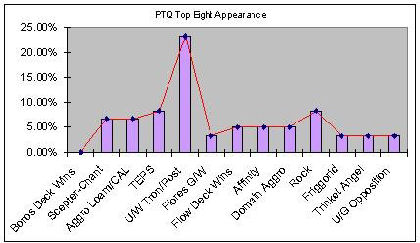
We can first compare this to the Extended overview of Worlds, which estimated the percentage share of all decks played at Worlds regardless of record, by a total of 316 competitors. This information is pretty readily available, in the online event coverage of Worlds (“Feature: Welcome To The New Extended, Not Quite The Same As The Old”, by Ted Knutson), in Frank Karsten’s Online Tech, or my article of several weeks ago, Magical Hack: Mining Extended. By so doing, we get the following graph, which gives us an idea as to how the metagame of “paper Magic” has ebbed and flowed… from round 1 of the World Championships to the Top 8 of the first two weeks of January’s PTQs:
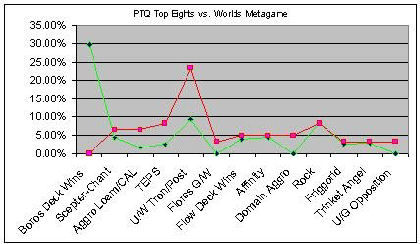
You’ll see already some pretty reasonable similarities in some of the trends, just by looking at the shape of the graph: there’s the same peak when you hit U/W Tron, another peak for The Rock, and some dips where decks that specifically didn’t exist at Worlds (G/W Flores Haterator, U/G Opposition, and apparently “Gaea’s Might Get There” a.k.a. “Domain Aggro”) happen to have broken into the Top 8. (Though one might note with only 276 / 316 Worlds decks fitting into a well-defined mould, U/G Opposition or Gaea’s Might Get There could have been played as lower-level decks that merely didn’t make the cut-off for being brought to your attention when Ted Knutson wrote his feature at Worlds.) Several of the trends seem very similar, except for one glaring fact: the king of the hill at Worlds, Boros Deck Wins, failed to make a dent in the Top 8 weeks 1-2 of the PTQ season. Already you can see that the Great White (… and Red) Hype of Worlds has been effectively unseated by a metagame that came prepared for it. This information is misleading, however, because in many ways it is comparing apples and oranges: mass action at Worlds versus successful results at PTQs. To really compare apples to apples, you want to compare the cream of the crop at Worlds against the cream of the crop at PTQs, thus giving us the following:
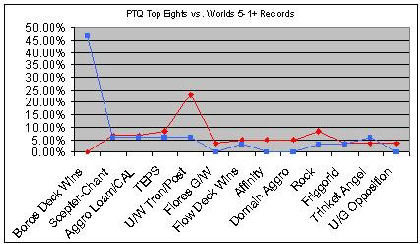
PTQ Top 8s are again the red line with the by-now distinctive little ups-and-downs we are going to get to know so well. Again we see the huge bias Worlds had, even success-wise, for Boros Deck Wins… it was the breakout deck of Worlds, with very nearly 50% of the successful (read: 5-1 or better) decks from Worlds appearing there. (Note also that we are omitting anything that falls outside of the archetypes currently on our radar, so decks like Sunny Side Up, Psychatog, or Balancing Tings are frankly just not being discussed. The PTQ data has zero data points for that, and we’re trying to figure out what the PTQ data compares to with the signal we do have, not the signal we don’t.)
Again, a few decks don’t exist yet, and U/W Tron no longer resembles the PTQ Top 8 Tron data, as the deck was played in significant portions at Worlds, but aside from a very limited few cases (Sooriani et al.) it did not see proportional success… it’s hard to beat a field of that many Boros decks, some of which will get lucky and go first, to put up a 5-1 or better record, regardless of what deck you’re playing. Besides Boros, which has fallen flat on its face on the PTQ circuit, the only deck with a higher percentage share at Worlds than in PTQs is Trinket Angels, which possibly suggests that the deck has not lived up to the hype following Worlds. Either that, or it’s not being played as much as it might warrant, being an unpopular choice in the current metagame as a whole rather than an unsuccessful one. Aside from the Boros = 50% “accident,” this data isn’t necessarily very far off, suggesting that perhaps a goodly sum of the players at PTQs are basing their choices heavily off the successful decks at Worlds.
But so far, we’re talking paper versus paper with a six-week time delay. Things get much more interesting when we start adding electronic Magic to the mix. Keep your eye on the bob-and-weave of the red line that distinguishes PTQ Top 8 results… we’re about to add in Weeks 48 – 52 of Magic Online Premiere Event Top 8 Results. Hold onto your hats, these graphs are about to get a lot more complicated:
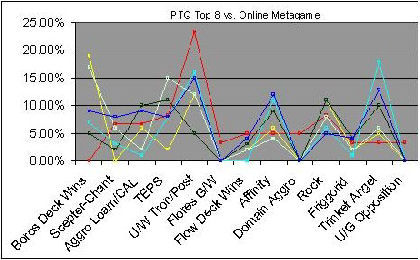

Don’t say I didn’t warn you. There’s a nice guide telling you which color is which week. The ebb and flow of the metagame on Magic Online goes like this: Boros starts out as the king of the hill in Weeks 48-49, after which it steadily drops down to half or less of its original percentage-share, while U/W Tron starts strong in the early weeks and builds up higher and higher by the time we get to Week 52. U/G Opposition still doesn’t exist yet, because it was an IRL innovation that did not port over to MTGO until after the Top 8 results for Week 2 became active, and as of Karsten’s Online Tech this past Wednesday (1-30-07) it has hit a 7% share of the metagame (up from last week’s paltry 1%) as it starts to impact the metagame. Flores G/W was known for at least the latter weeks of the events, but still has no impact on the online metagame, making it a flash in the pan that somehow managed to qualify one or two people somewhere before falling back off the radar. Domain Aggro likewise has a zero market-share of the Weeks 48 – 52 Top 8s, showing up just this past week at 2%, up from last week’s 0% non-appearance.
For those three decks, U/G Opposition, G/W Haterator, and “Gaea’s Might Get There” (Domain Aggro / Domain Zoo), the time-shift between appearing in the paper metagame and its eventual appearance in the electronic metagame is pretty clear: data becomes available, and about two weeks later that “new” deck is a functioning component of the online metagame. The shift from real-life innovation to online innovation thus effectively has about a one-week lag, a reasonable time for online players to contemplate a switch, trade for cards, and practice some with the deck before enlisting in their first Premiere Event. Especially considering that some decks you see here are quite expensive tickets-wise to “just” assemble… one week seems very fair, especially since by the time the end of two weeks have rolled around these decks seem to be added and integrated into the metagame if they’re good… or forgotten if they’re not. (Sorry Haterator.)
Over all of these different data points per deck, and all of these weeks, you’ll see some places where they mesh up very neatly with each other (notice how neatly the TEPS data-points overlap after the first two weeks, in which it went from relatively nonexistent to swarming the metagame, then for Week 50 settles in with its presumed “real” value for the next three weeks, which match up with the PTQ Weeks 1-2 results fairly neatly) and some places where they clearly don’t… Aggro-Loam / The CAL seems to fluctuate pretty wildly from week to week, first trending low for Weeks 49-50 and then flaring up for Weeks 51-52.
Mathematically, if we wanted to be hyper-attentive to details, we could do what is known as a Least Squares Analysis for each Online Week graph versus the PTQ results line, to figure out what Excel insists is the best mathematical “fit” when comparing the online metagame to the real world. This definitely has some merits, but in the grander scope of things it’s just using math to “eyeball” it, and it doesn’t have the benefit of seeing how the trends are going. All it takes is one bad data point, like Week 51’s U/W Tron drop-off, to kill what might otherwise seem to be a very nice fit.
Instead, I think it’s best to choose a reasonable point to chop it off, as we can already see there seems to be a Tier 1 metagame and a Tier 2 metagame starting to establish itself. Sure, the right-hand side of the graph has some pretty high values in places (Week 50 with Trinket Angel, anyone?) but these are all very quickly fluctuating, and by the time of the first week of PTQs these haven’t yet hit their equilibrium online, they’re largely newer decks that weren’t already being played on MTGO before Worlds and thus are going through their online honeymoons as it were. Chopping off at U/W Tron, we can compare the known-good online metagame with their analogues in the real world, giving us the following:

This gives us a solid close-up, as it were, on all of these lines… and it seems pretty clear to me that it is the dark blue line of Week 52 that most nearly matches up with the Top 8 results at PTQs, the red line we’ve been tracking so far. Other than the Boros debacle, where we see Boros Deck Wins failing initially at the start of the PTQ season, it’s trending in the right direction for the other decks, is very close to each result, and doesn’t have some of the more divergent trending you can see even as early as a single week before the PTQs start. It seems pretty clear, here, that the PTQ results very directly follow the online results… what you read about in Online Tech and This Week on MTGO on Wednesdays is more or less what you can expect to be doing well at your in-real-life PTQ the following Saturday.
Of course, this is merely the hypothesis, and to actually attempt to prove that the real-life metagame is lagging one week behind the electronic metagame, you should first check your assumptions. Comparing the PTQ Week 1-2 Top 8 Decks to the 2007 Weeks 1-3 online Premier Events Top 8 Decks and that metagame is then necessary, with the expectation that the Week One metagame would look something like the PTQ results, because those look something like what happened the week before. Looking at the ebb and flow of the metagame in motion, and following the red bouncing line, we see:
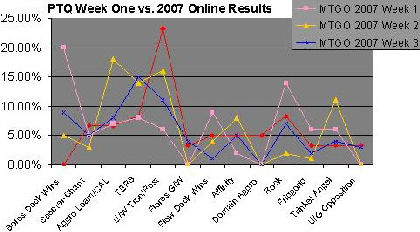
The trends for Week 1, the pink line, sort of mesh with the Week 1 PTQ results… again we have Boros absent in the PTQ results but present in a considerable portion of the online results, and for Online Week 1 you see a quick drop-off from U/W Tron decks following the Week 52 spike, which later comes back in subsequent weeks. Note that when Boros is high, U/W Tron is low, they seem to be in some sort of an equilibrium. Don’t let Internet pundits Zac Hill and Richard Feldman from this here site here totally pull the wool over your eyes: U/W Tron decks are not invulnerable to Boros decks, and their watershed technology break of using Gifts Ungiven is not to be over-estimated, their advisements of its improvement over “normal” Tron aside. Tron decks are appearing in amazing numbers in real-life metagames, while Boros isn’t cracking into the Top 8 at all… suggesting that if Boros were more prevalent, Tron might be less prevalent, and not just because you’re trading Tron players for Boros players one-for-one.
You again lose out at the right-hand end of the graph, where we see decks that are going from the paper metagame onto the electronic metagame with some lag. After Week 2, some of these results start to be available to the Internet community and thus we start to see U/G Opposition and G/W Haterator finally start to trickle into the metagame. You can see Destructive Flow decks (grouped together as Flow Deck Wins and Aggro Flow Rock in Karsten’s numbers, as there is not a sufficiently accurate place to draw the line between competing designs of Destructive Flow decks) steadily dropping over time, after reaching a peak of sorts between Week 52 and Week 1 of 2007, probably analogous to Flow’s sudden surge in PTQ results as seen in Week 4 data starting to trickle in as of yesterday’s Swimming With Sharks.
While the 2007 Week 1 results are something of a close fit, the PTQ Top 8 Decks result seems more closely to fit the 2006 Week 52 results, as you can see when you narrow it down to just 2006 Week 52 versus 2007 Week 1:
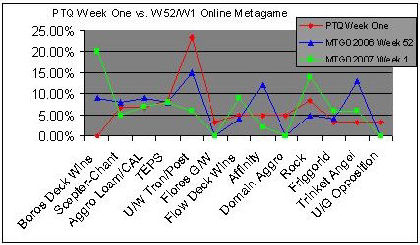
It seems clear then that the online results are driving the metagame, at this point, especially since the advent of weekly reporting of the Magic Online metagame, pioneered as “This Week On MTGO” by Ray “Blisterguy” Walkinshaw, and more recently up-jumped to a higher form as “Online Tech” by Frank Karsten. A year ago, the idea of Magic Online being “ahead” of the real-life metagame, and a source of innovations at least equal to those found offline, would have been considered laughable. Now we seem to have reached two critical watersheds: player base and information availability.
The player base of Magic Online has been consistently swelling as new players start shuffling up electronic decks, and more and more players begin taking the steps that lead to online collections… and online competition. Some costs are prohibitive – the fact that Scepter-Chant is being played at all despite its playing four copies of a card that usually ranges in the 90-100 “tickets” range is almost unreal, and seeing the level of dominance that Trinket Angel is reaching (as high as a 10% share of the Top 8 berths in some weeks) is despite the fact that Meddling Mage, a key component of the deck, is a 60-ticket four-of. We have long since reached a sufficient volume to allow for electronic play to mirror real-world play, save with the benefits of being able to compete at any time of the day (… or night) without ever needing to even leave the house (… or get dressed, for that matter).
Statistical analysis of Magic Online results is also more readily possible, as the kind of information you need for a true statistical analysis is rarely present at any specific event nowadays, but Magic Online logs games to be watched in replay mode for each tournament. Frank Karsten (and, to a lesser degree, “BTape" on the StarCityGames.com and MiseTings forums) has recently been applying statistical methods to determine “the best deck” in the format, having used plentiful play results and a reasonably intuitive mathematical formula to calculate the expected value of each deck in Extended, starting with a matchup analysis for each deck-on-deck combination. (“BTape” has been posting about MTGO results for PE’s he’s been in, with scouting information and individual finishes and ratings, and could even go further by tracking round-by-round information to get the same kinds of results Karsten has been obtaining… but is worth noting anyway, as his recording of ratings adds an additional layer of complexity to what is going on. Look here if you’re interested.)
Using Karsten’s method, tracking populations week by week and an overall matchup percentage and adding together (chance of victory) x (percentage of population) for each matchup present, compiles the expected value of doing well with any given deck… and his main conclusion was that Aggro Loam and Scepter-Chant were the two best decks, by the numbers, to play at any given moment. Scepter-Chant, at least, is constrained by the availability and expense of cards online… but Aggro Loam was the leading dominant deck on MTGO prior to Worlds, where it was only poorly represented by the “real-life” paper World Championships players, with a total of five players. That we have a large enough stable gaming population on Magic Online that such statistical analyses are not merely feasible but could be done repeatedly, on a monthly, weekly or even daily basis, once the method is put into place (and presumably somehow automated at least in part). MTGO has passed the watershed from being a “Magic video game” to becoming “the electronic form of Magic: the Gathering.”
Information availability, then, is key. Recall this past summer, where the National Championships season saw a boom in paper Magic of decks that had previously only been known through online play, specifically Solar Flare. The Worlds metagame was in no way representative of the metagame on Magic Online, with the prior known “best deck” over several months of play all but ignored by 311 of 316 Day 3 competitors. The cross-pollination of ideas from electronic to real-life medium is astounding, with a minimal lag going from electronic Magic to real-life Magic. The Week 52 metagame as reported by Frank Karsten in Online Tech three days before the first PTQ was fairly accurately representative of the real-life metagame, which as we said looked more or less nothing like the World Championships metagame, either the starting metagame or the more refined metagame of “successful decks” seen in the third graph above. What you read about on Wednesday in Online Tech is what you’ll be playing against Saturday at the PTQ.
Whether Online Tech, or for that matter This Week On MTGO, is “responsible” for spreading metagame information isn’t really relevant… a significant-enough portion of the metagame of real-life players are informed by online results either personally or through teammates and friends, so the spread of ideas from online results to offline players is quick and continuous. Note, however, that real-life Magic ideas spread very slowly back onto the computer; decks appearing Week 2 of January on the PTQ circuit did not appear online till the end of Week 3 at all, and didn’t have a serious impact until Week 4 of January. Information in the real world moves slower, not being on an instant-gratification worldwide distributed network populated by lots and lots of people who apparently have nothing better to do at two in the morning than play another 8-man Extended queue to practice for the next day’s Premier Event.
Real-life Magic has been using the Internet as an information-sharing tool since before even the days of The Magic Dojo, back when “reading an article on the Internet” meant typing rec. or alt. into the browser, often followed by an alphabet soup of gobbledygook to find the right newsgroup for your discussion. Information travels quickly and through a variety of sources, with MagicTheGathering.com serving the role as information hub ever since it started collating PTQ Top 8 results in a forum viewable by anyone and updated reasonably quickly. Two years or so ago, the ease with which this information is now collected and collated as seen on Swimming With Sharks, among other places, would have been astounding. It frankly didn’t exist in anything approaching its modern form before the Kamigawa Block Constructed season. But these information sources are still sluggish compared to the speed at which information can be conveyed, relying on tournament organizers to post decklists and weekly columnists to get to their day of the week to share information, analysis and results with a worldwide readership. Magic Online has no such time constraints with how quickly information is shared. This is the only reason it ever lags behind paper Magic innovations, because the real-life “distributed network” of worldwide Magic players is far more “distributed” and fragmented than inside the MTGO “network.” Paper Magic just works slower than Magic Online, and so it should come as no surprise then that real-life metagames trail behind electronic metagames…
… But the savvy reader will note that this means electronic results are an amazing predictor of real-life metagames, allowing such complex calculations as Karsten’s statistical treatment of matchup data to calculate “the best deck to play” in any format. Mike Flores, Magic innovator extraordinaire and key member of Cabal Rogue, often talks about getting an “edge on deck” … finding The Deck for any particular tournament, and using rigorous testing methods alongside fresh designs and innovations to gain the best expected value for the tournament. One key failing he often notes is that he cannot perfectly predict the metagame at any given tournament, in addition to his only pseudo-mathematical treatment of what these “edges” are… but it seems apparent that Magic Online itself is the perfect predictor of the real-life metagame, albeit an insular one that is resistant to innovations that come from the Magic-playing world outside of its resident body of players.
Maybe you knew all this and this was “an article about nothing,” except that I’m not quite as funny as Jerry Seinfeld (ha!). But it never hurts to attempt to prove something is true, validating a tool for the particular use you intend it to perform, and in the case of using Magic Online as an accurate predictive tool for the real-world metagame… what seems intuitive isn’t always right. Many paper mages would say that there is an inherent difference between real-world cards and blinking electronic lights on your monitor, no different than perhaps any digital character in any other video game, there solely for your amusement. Fewer still seem to understand that there is a difference… and that the difference is that their bulky Magic cards with things like mass and dimensions and molecular structures that baffle those of primitive intellect, they’re just slower than electronic Magic cards. It is “Paper Magic” that is the primitive format, and Electronic Magic the graceful flagship of progress and technology.
Or at least that’s what the numbers tell me. Maybe that just backs up my pre-existing argument that I should be playing Scepter-Chant in Extended because it’s one of the best decks… but I suspect I’d be more willing to use any tool I thought would get me the win, and not be too terribly attached to whatever new thing someone at Worlds invented that I seemed to have taken as my own after changing five cards. The tool has been there for some time – but recognizing it for what it is has taken many people far longer.
Sean McKeown
smckeown @ livejournal.com
smcke0wn on MTGO
Before you tell yourself it’s just a different scene
Remember, it’s just different from what you’ve seen…
I’m looking at you through the glass
Don’t know how much time has passed
Now all I know is that it feels like forever…
Stone Sour, “Through Glass”
… although as far as this article would be concerned, it might as well be titled “An Ode To My Disconnected Opponent”

